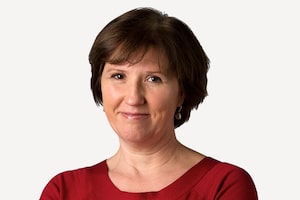The five top-grossing films in the world in calendar 2001 were Harry Potter and the Philosopher's Stone ($750.4-million U.S.), Shrek ($465.7-million), Pearl Harbor (450.2-million), The Mummy Returns ($429.4-million) and Jurassic Park III ($363.5-million). Though they varied wildly in terms of originality, script quality, storytelling and acting, they had one thing in common: stunning visual effects. Copious, elaborate, brain-bending effects (or f/x) comprised much of their appeal -- in the case of the last three, their only appeal.
Now consider the five Oscar nominees for the best picture of 2001: A Beautiful Mind, Gosford Park, In the Bedroom, Moulin Rouge and The Lord of the Rings: The Fellowship of the Ring. Whatever their other merits, each has been nominated mainly because it's a good old-fashioned yarn -- respectively, an inspirational biopic, a classy whodunit, a gripping family drama, a teary love story, and a fantasy quest based on a 48-year-old novel. Only The Lord of the Rings wove visual effects into its very being. It was also the only top-10 grossing nominee (number 8, with $339.1-million).
On one hand, mainstream movies spend more time and money on f/x than on story development. When they hit a plot snag, the filmmakers jam in a few extra effects and tell themselves we'll never notice. If the movies earn big, the f/x budgets for their sequels are bumped up even further.
On the other hand, when it comes time to hand out awards, those same filmmakers turn up their noses at effects-centric pictures, and retreat to hushed, highbrow art films. They're so much classier and more deserving. During awards season, caring about box office is crass.
In fact, as recently as six years ago, there wasn't even a separate Oscar for visual effects. Before that, the category came and went: If one film in a particular year had outstanding effects, it might get a special technical award; if two or three films shone, they might compete. But there was no consistency.
Then, in 1995, visual-effects specialists formed their own branch of the Academy of Motion Picture Arts and Sciences and petitioned for a guaranteed Oscar. They got it, but were allotted only three nominees; most other categories have five. "Maybe eventually they'll get five," said Rich Miller, the academy's awards administrative director. "But they're still a relatively new branch. They have to do things one step at a time."
Directors, screenwriters and especially actors (the bulk of the academy's 5,600 members) may be reluctant to acknowledge the importance of f/x to their business, and how it increases exponentially every year. But the 230 members of the visual-effects branch know their value, and keep a tight reign over their Oscar.
This year's three nominees were chosen by an appropriately complicated process. First, a 40-member steering committee, comprised of top digital, matte- and physical-effects supervisors, met during the first week of January in L.A. Led by chairman Richard Edlund, an Oscar-winning visual f/x supervisor who's worked on more than 30 films, including Star Wars, Raiders of the Lost Ark, and Ghostbusters,they narrowed down the 248 eligible films to 30 effects-heavy titles.
After debating the merits of those 30 for a few hours, they -- with the help of secret ballots and Price Waterhouse accountants, who were on hand to tally the votes -- came up with eight semi-finalists: A.I. (which grossed $235-million, by the way), Black Hawk Down ($101.3-million and rising), Cats and Dogs ($200-million), The Fast and the Furious ($206.5-million), Harry Potter, Jurassic Park III, The Lord of the Rings and Pearl Harbor.
Those semi-finalists made highlight reels, which were shown a few weeks later to the entire branch, plus assorted guests, who filled the academy's 1,000-seat Samuel Goldwyn theatre. There, they chose the three nominees: A.I., The Lord of the Rings and Pearl Harbor. Only now can the rest of the academy vote for a winner.
Despite this process -- and their films' grosses -- much remains beyond the f/x wizards' reach. The directors' guild still decides who gets credit for what on a film; sometimes they assign titles for their techies "willy-nilly, which dilutes the meaning of our credit," Edlund told me.
As well, many effects supervisors who want to become directors can't get hired. They're dismissed as techno-geeks, even though many work closely with screenwriters and directors, and handle huge budgets (the f/x budget on the next Harry Potter movie is reportedly $60-million -- half of its entire budget, and more than the average Hollywood film). They have to sit idly by while video and commercial directors with far less experience snag feature deals.
"Those people have something concrete to show executives," said Edlund, whose own efforts to direct a feature film have so far been unsuccessful. "Whereas our work, if it's successful, is invisible."
But I don't think f/x guys are being passed over because they don't know enough. I think it's because they know too much. "Every year, there are more movies that really hinge on effects," Edlund said. " Lord of the Rings and Harry Potter wouldn't play without them. Neither would A.I. or Pearl Harbor,or lots of others." Including most of the top-20 grossers, if not yet the best-picture nominees.
 Johanna Schneller
Johanna Schneller